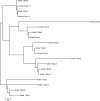Fresh is best: Accurate SNP genotyping from koala scats
- PMID: 29607013
- PMCID: PMC5869377
- DOI: 10.1002/ece3.3765
Fresh is best: Accurate SNP genotyping from koala scats
Abstract
Maintaining genetic diversity is a crucial component in conserving threatened species. For the iconic Australian koala, there is little genetic information on wild populations that is not either skewed by biased sampling methods (e.g., sampling effort skewed toward urban areas) or of limited usefulness due to low numbers of microsatellites used. The ability to genotype DNA extracted from koala scats using next-generation sequencing technology will not only help resolve location sample bias but also improve the accuracy and scope of genetic analyses (e.g., neutral vs. adaptive genetic diversity, inbreeding, and effective population size). Here, we present the successful SNP genotyping (1272 SNP loci) of koala DNA extracted from scat, using a proprietary DArTseq™ protocol. We compare genotype results from two-day-old scat DNA and 14-day-old scat DNA to a blood DNA template, to test accuracy of scat genotyping. We find that DNA from fresher scat results in fewer loci with missing information than DNA from older scat; however, 14-day-old scat can still provide useful genetic information, depending on the research question. We also find that a subset of 209 conserved loci can accurately identify individual koalas, even from older scat samples. In addition, we find that DNA sequences identified from scat samples through the DArTseq™ process can provide genetic identification of koala diet species, bacterial and viral pathogens, and parasitic organisms.
Keywords: SNP Genotyping; diet; disease; koala; scat.
Figures



Similar articles
-
The Utility of the Koala Scat: A Scoping Review.Biology (Basel). 2024 Jul 15;13(7):523. doi: 10.3390/biology13070523. Biology (Basel). 2024. PMID: 39056716 Free PMC article.
-
Reliable genotyping of the koala (Phascolarctos cinereus) using DNA isolated from a single faecal pellet.Mol Ecol Resour. 2013 Jul;13(4):634-41. doi: 10.1111/1755-0998.12101. Epub 2013 Apr 15. Mol Ecol Resour. 2013. PMID: 23582171
-
Advancements in noninvasive koala monitoring through combining Chlamydia detection with a targeted koala genotyping assay.Sci Rep. 2024 Dec 5;14(1):30371. doi: 10.1038/s41598-024-76873-1. Sci Rep. 2024. PMID: 39638795 Free PMC article.
-
Scat as a source of DNA for population monitoring.Ecol Evol. 2022 Oct 30;12(11):e9415. doi: 10.1002/ece3.9415. eCollection 2022 Nov. Ecol Evol. 2022. PMID: 36329814 Free PMC article.
-
Helping koalas battle disease - Recent advances in Chlamydia and koala retrovirus (KoRV) disease understanding and treatment in koalas.FEMS Microbiol Rev. 2020 Sep 1;44(5):583-605. doi: 10.1093/femsre/fuaa024. FEMS Microbiol Rev. 2020. PMID: 32556174 Free PMC article. Review.
Cited by
-
The Utility of the Koala Scat: A Scoping Review.Biology (Basel). 2024 Jul 15;13(7):523. doi: 10.3390/biology13070523. Biology (Basel). 2024. PMID: 39056716 Free PMC article.
-
Testing the effectiveness of genetic monitoring using genetic non-invasive sampling.Ecol Evol. 2021 Dec 27;12(1):e8459. doi: 10.1002/ece3.8459. eCollection 2022 Jan. Ecol Evol. 2021. PMID: 35127011 Free PMC article.
-
Genomic comparisons reveal biogeographic and anthropogenic impacts in the koala (Phascolarctos cinereus): a dietary-specialist species distributed across heterogeneous environments.Heredity (Edinb). 2019 May;122(5):525-544. doi: 10.1038/s41437-018-0144-4. Epub 2018 Sep 12. Heredity (Edinb). 2019. PMID: 30209291 Free PMC article.
-
Koala Genome Survey: An Open Data Resource to Improve Conservation Planning.Genes (Basel). 2023 Feb 22;14(3):546. doi: 10.3390/genes14030546. Genes (Basel). 2023. PMID: 36980819 Free PMC article.
-
A method for noninvasive individual genotyping of black-footed cat (Felis nigripes).Ecol Evol. 2024 Apr 23;14(4):e11315. doi: 10.1002/ece3.11315. eCollection 2024 Apr. Ecol Evol. 2024. PMID: 38660470 Free PMC article.
References
-
- Altschul, S. F. , Gish, W. , Miller, W. , Myers, E. W. , & Lipman, D. J. (1990). Basic local alignment search tool. Journal of Molecular Biology, 215, 403–410. - PubMed
-
- Bjelland, D. W. , Weigel, K. A. , Vukasinovic, N. , & Nkrumah, J. D. (2013). Evaluation of inbreeding depression in Holstein cattle using whole‐genome SNP markers and alternative measures of genomic inbreeding. Journal of Dairy Science, 96, 4697–4706. - PubMed
Associated data
LinkOut - more resources
Full Text Sources
Other Literature Sources

